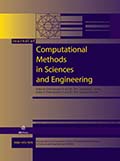Authors: Belkić, Dževad
Article Type:
Research Article
Abstract:
This review is on quantum-mechanical signal processing based upon the Padé approximant (PA). We presently link the PA and the Lanczos algorithm to design the Padé-Lanczos approximant (PLA). The PLA is operationalized with the recursive algorithm called the fast Padé transform (FPT) for both parametric and nonparametric estimations of spectra. The FPT for any given power series is defined by the unique quotient of two polynomials. This processor provides a meaningful result even when the original expansion diverges. It can significantly accelerate slowly converging sequences/series. As opposed to a single polynomial, e.g. the fast Fourier transform (FFT), the FPT can
…analytically continue general functions outside their definition domains. Moreover, we show that the FPT is an efficient solver of generalized eigenproblems e.g. the quantum-mechanical evolution/relaxation matrix U comprised of auto-correlation functions. These generic functions can be either computed theoretically or measured experimentally. Such a concept, put forward as a computational tool, surpasses its initial purpose. Indeed auto-correlation functions represent a veritable alternative formulation of quantum mechanics. This is not just because all the major observables e.g. complete energy spectra, local density of states, quantal rate constants, etc, are expressible through the auto-correlation functions. It is also because these and other observables could be given completely in terms of some appropriate, relatively small informational parts that can be singled out and analyzed separately from the unwanted/redundant remainder of the full data set of auto-correlation functions. The needed dimensionality reduction of original large problems treated by the FPT can be achieved by e.g. windowing using the band-limited decimation. Alternatively, as done in this work, the Lanczos tridiagonalization can be employed yielding sparse Jacobi matrices in terms of the Lanczos coupling parameters { α n , β n } that have their very important physical interpretations. The FPT is naturally ingrained in the SchrÃűdinger picture of quantum mechanics and in the total time-independent Green function for the studied system. This yields a versatile framework for a unified treatment of spectroscopy and collision within signal processing and quantum mechanics. In the quantum-mechanical method of nearest neighbors or tight bindings, we use experimentally measured time signals as the only input data to derive the exact analytical expressions for the FPT, the Lanczos polynomials { P n ( ω ) , Q n ( ω ) } , the couplings { α n , β n } , the Lanczos state vectors ψ n , the total wave function Υ ( ω ) at any frequency ω and the ‘Hamiltonian’ operator Ω ˆ . An extension of the FPT to multi-dimensional analysis is also given for usage in very diverse fields. The FPT is presently illustrated with multiple numerical quadratures and with spectral analysis of two time signals from nuclear magnetic resonance encoded in a healthy human brain.
Show more
Keywords: Padé approximant, continued fractions, Lanczos algorithm, signal processing, 30B70, 30E05, 33D45, 4fA2f, 62Fxx, 65Bxx, 94Af2
DOI: 10.3233/JCM-2003-3109
Citation: Journal of Computational Methods in Sciences and Engineering,
vol. 3, no. 1, pp. 109-186, 2003
Price: EUR 27.50





